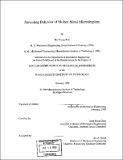Spreading behavior of molten metal microdroplets
Author(s)
Kim, Ho-Young, 1971-
DownloadFull printable version (10.95Mb)
Other Contributors
Massachusetts Institute of Technology. Dept. of Mechanical Engineering.
Advisor
Jung-Hoon Chun.
Terms of use
Metadata
Show full item recordAbstract
Deposition of molten microdroplets is fundamental to many emerging droplet-based manufacturing (DBM) processes. Although the spreading behavior of ordinary liquid and molten droplets has been studied extensively for years, some basic questions remain unanswered. Specifically, the fundamental mechanisms of abnormal spreading behavior, such as splashing and bouncing, have yet to be satisfactorily addressed. An understanding of these mechanisms is essential to determine the optimal deposition conditions for the DBM process. This thesis investigates the fundamental, but poorly understood, behavior of liquid and molten metal droplets upon impact on solid surfaces. The splashing of liquid droplets is addressed first. A linear perturbation theory is developed for the interface instabilities of a radially-expanding, liquid sheet in cylindrical geometries. The theory is then applied to rapidly spreading droplets as the fundamental mechanism behind splashing. The effects of such factors as the transient profile of the interface radius, the perturbation onset time, and the Weber number on the analysis results are examined. The analysis shows that the wave number of maximum instability does not remain constant but rather, changes during spreading because of time-dependent coefficients in the amplitude equation. A large impact inertia, associated with a high Weber number, promotes interface instability and prefers high wave number for maximum instability. The next stage investigates the oscillations of liquid droplets upon collision with solid surfaces as a prerequisite for understanding droplet bouncing. Experiments using a high speed video system show that the droplets with higher impact inertia oscillate more vigorously upon collision. The oscillation is strongly affected by the wetting between the liquid droplet and the solid surface, such that the oscillation is greatly promoted in poor wetting conditions. In addition, this thesis develops approximate models based on the variational principle, rather than the Navier-Stokes equation to simulate the droplet oscillation. The results of the models are in good agreement with the experimental data. The analysis shows that the relative magnitudes of surface energy and viscous dissipation play critical roles in determining droplet dynamics. Following the oscillation study, the bouncing of molten metal droplets upon collision with subcooled target surfaces is studied. To determine the conditions for bouncing and sticking, an empirical regime map is constructed using an approximate model and extensive experimental data. A clear trend develops, illustrating that bouncing occurs when solidification is slow compared to oscillation, when a molten metal droplet collides with a non-wetting surface. It is also found that bouncing is prohibited by good wetting between the droplet and the target, which suggests that the wetting be an additional parameter affecting the bouncing behavior.
Description
Thesis (Ph.D.)--Massachusetts Institute of Technology, Dept. of Mechanical Engineering, 1999. Includes bibliographical references (p. 84-89).
Date issued
1999Department
Massachusetts Institute of Technology. Department of Mechanical EngineeringPublisher
Massachusetts Institute of Technology
Keywords
Mechanical Engineering.